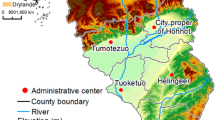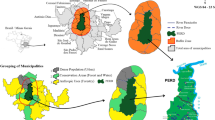Abstract
Projections of future land-cover (LC) change are challenging because of the multitude of spatial and dynamic drivers involved, such as politics, economics, demographics, and the environment. This paper presents a combined qualitative and quantitative scenario approach for giving consistent projections of urban and rural land-cover change (LCC), considering both the demands of certain LC types, and their allocation. The approach has been implemented in the Upper Western Bug River catchment in Ukraine in the context of integrated water resource management. Special attention is paid to the identification of spatial and dynamic drivers of LCC, the scenario formulation and projection of the identified drivers, and the projections of alternative plausible LCC. The identification of spatial and dynamic drivers is based on the detection of retrospective LCC, statistical analysis of interrelations between LCC and drivers, and expert validation of transition rules. The scenario formulation and projection of the drivers involve storylines with inputs from expert interviews. The creation of future LC change projections followed four steps: suitability maps from retrospective LCC detection, expert validation, the future development of drivers, and the allocation of LCC. Results indicate demographic change and GDP development as dynamic drivers mainly influencing the LCC, as other studies have implied. Furthermore, there are spatial drivers influencing the local allocation such as the regional capital of Lviv, and they are shaped by, for example, environmental laws, distances to roads and settlements, slope, and soil fertility.
Similar content being viewed by others
Notes
Therefore, the phrase “up to” is used, e.g. 0 to 200 m is presented as “up to 200 m”.
References
Alcamo J (2001) Scenarios as tools for international environmental assessment. Environmental Issue Report (24)
Alcamo J (2008) Chapter one introduction: the case for scenarios of the environment. In: Alcamo J (ed) Developments in integrated environmental assessment. Elsevier, Amsterdam, pp 1–11
Alcamo J, Kreileman GJJ, Krol MS, Zuidema G (1994) Modeling the global society-biosphere-climate system: part 1: model description and testing. Water Air Soil Pollut 76:1–35
Bahrenberg G, Giese E, Mevenkamp N, Nipper J (2010) Statistische Methoden in der Geographie—1: Univariate und bivariate Statistik, 5. vollst. neubearb. und korr. Aufl. Borntraeger
Baumann M, Kuemmerle T, Elbakidze M et al (2011) Patterns and drivers of post-socialist farmland abandonment in Western Ukraine. Land Use Policy 28:552–562. https://doi.org/10.1016/j.landusepol.2010.11.003
Blumensaat F, Wolfram M, Krebs P (2012) Sewer model development under minimum data requirements. Environ Earth Sci 65(5):1427–1437. https://doi.org/10.1007/s12665-011-1146-1
Boarnet MG, McLaughlin RB, Carruthers JI (2011) Does state growth management change the pattern of urban growth? Evidence from Florida. Reg Sci Urban Econ 41:236–252. https://doi.org/10.1016/j.regsciurbeco.2010.12.004
Bürgi M, Hersperger AM, Schneeberger N (2004) Drivers of landscape change—current and new directions. Landsc Ecol 19:857–868. https://doi.org/10.1007/s10980-004-0245-8
Burmeister C, Schanze J (2016) Retrospective analysis of systematic land-cover change in the upper Western Bug River catchment, Ukraine. ACC J 22:7–18. https://doi.org/10.15240/tul/004/2016-1-001
Busch G (2006) Future European agricultural landscapes—what can we learn from existing quantitative land use scenario studies? Agric Ecosyst Environ 114:121–140. https://doi.org/10.1016/j.agee.2005.11.007
Core Team R (2013) R: A language and environment for statistical computing. Austria, Vienna
Ertel A-M, Lupo A, Scheifhacken N et al (2011) Heavy load and high potential: anthropogenic pressures and their impacts on the water quality along a lowland river (Western Bug, Ukraine). Environ Earth Sci 65(5):1459–1473
FAO, UNEP (1999) The future of our land. Facing the challenge. Guidelines for integrated planning for sustainable management of land resources. ISBN 92-5-104366-9, URL: http://www.fao.org/docrep/004/x3810e/x3810e00.htm. 28 Dec 2017
Goodacre AK, Bonham-Carter GF, Agterberg FP, Wright DF (1993) A statistical analysis of the spatial association of seismicity with drainage patterns and magnetic anomalies in western Quebec. Tectonophysics 217:285–305. https://doi.org/10.1016/0040-1951(93)90011-8
Hagemann N, Blumensaat F, Tavares Wahren F et al (2014) The long road to improving the water quality of the Western Bug River (Ukraine)—a multi-scale analysis. J Hydrol 519:2436–2447. https://doi.org/10.1016/j.jhydrol.2014.01.013
Helm B (2012) Stream network of the western bug river catchment. Geo-Data, Own Calculations
Houet T, Loveland TR, Hubert-Moy L et al (2010) Exploring subtle land use and land cover changes: a framework for future landscape studies. Landsc Ecol 25:249–266. https://doi.org/10.1007/s10980-009-9362-8
Hoymann J (2012) Quantifying demand for built-up area. A comparison of approaches and application to regions with stagnating population. J Land Use Sci 7:67–87. https://doi.org/10.1080/1747423X.2010.522600
HUSuLO (2000) Holovne Upravlinnia Statystyky u Lvivskiy Oblasti (HUSuLO)—the main department of statistics in Lviv oblast
Kosow H, Gassner R (2008) Methoden der Zukunfts- und Szenarioanalyse. Überblick, Bewertung und Auswahlkriterien
Kudelia S (2012) The sources of continuity and change of Ukraines incomplete state. Communist Post-Communist Stud 45:417–428. https://doi.org/10.1016/j.postcomstud.2012.06.006
Kuzio T (2011) Political culture and democracy. East Eur Polit Soc 25(1):88–113
Lakes T, Mueller D, Krueger C (2009) Cropland change in southern Romania: a comparison of logistic regressions and artificial neural networks. Landsc Ecol 24:1195–1206
Lambin EF, Turner BL, Geist HJ et al (2001) The causes of land-use and land-cover change: moving beyond the myths. Glob Environ Change 11:261–269. https://doi.org/10.1016/S0959-3780(01)00007-3
Leser H, Klink H-J (Editor) (1988) Handbuch und Kartieranleitung Geoökologische Karte 1:25.000 (KA GÖK 25). Bearbeitet vom Arbeitskreis Geoökologische Karte und Naturraumpotential. Forschungen zur deutschen Landeskunde 228, Trier
Lindquist EJ, D’Annunzio R, Gerrand A, MacDicken K, Achard F, Beuchle R, Brink A, Eva HD, Mayaux P, San-Miguel-Ayanz J, Stibig H-J (2012) Global forest land-use change 1990–2005. Food and Agriculture Organization of the United Nations, European Commission Joint Research Centre, Rome
Malek Z, Boerboom L (2015) Participatory scenario development to address potential impacts of land use change: an example from the Italian Alps. Mt Res Dev 35:126–138. https://doi.org/10.1659/MRD-JOURNAL-D-14-00082.1
Marks R, Müller M, Leser H, Klink H-J (eds) Anleitung zur Bewertung des Leistungsvermögens des Landschaftshaushaltes. Forschungen zur Deutschen Landeskunde, Band 229, 1992
Marsaglia G, Tsang WW, Wang J (2003) Evaluating Kolmogorov’s distribution. J Stat Softw 8:1–4. https://doi.org/10.18637/jss.v008.i18
Müller D, Munroe DK (2008) Changing rural landscapes in Albania: cropland abandonment and forest clearing in the postsocialist transition. Ann Assoc Am Geogr 98:855–876. https://doi.org/10.1080/00045600802262323
Nakicenovic N, Swart R (eds) (2000) Emissions scenarios. Cambridge University Press, Cambridge
Narayanan BG, Walmsley TL (2008) Global Trade, Assistance, and Production: The GTAP 7 Data Base
Niehoff D, Fritsch U, Bronstert A (2002) Land-use impacts on storm-runoff generation: scenarios of land-use change and simulation of hydrological response in a meso-scale catchment in SW-Germany. J Hydrol 267:80–93. https://doi.org/10.1016/S0022-1694(02)00142-7
Pahl-Wostl C. (2008). Chapter five participation in building environmental scenarios. In: Developments in integrated environmental assessment. J Alcamo 2:105–22. Environmental futures the practice of environmental scenario analysis. Elsevier
Pavlik D, Soehl D, Pluntke T, Mykhnovych A, Bernhofer C (2011) Dynamic downscaling of global climate projections for Eastern Europe with a horizontal resolution of 7 km. Environ Earth Sci. https://doi.org/10.1007/s12665-011-1081-1
Petrov LO, Lavalle C, Kasanko M (2009) Urban land use scenarios for a tourist region in Europe: applying the MOLAND model to Algarve, Portugal. Landsc Urban Plan 92:10–23. https://doi.org/10.1016/j.landurbplan.2009.01.011
Pontius RG, Shusas E, McEachern M (2004) Detecting important categorical land changes while accounting for persistence. Agric Ecosyst Environ 101:251–268. https://doi.org/10.1016/j.agee.2003.09.008
Prishchepov A, Müller D, Dubinin M et al (2013) Determinants of agricultural land abandonment in post-Soviet European Russia. Land Use Policy 30:873–884. https://doi.org/10.1016/j.landusepol.2012.06.011
Ramírez R, Selin C (2014) Plausibility and probability in scenario planning. Foresight 16:54–74. https://doi.org/10.1108/FS-08-2012-0061
Riabchuk M (2008) Ukraine: lessons learned from other postcommunist transitions. Orbis 52(1):41–64
Rothman DS (2008) Chapter three: A survey of environmental scenarios. In: Alcamo J (ed) Developments in integrated environmental assessment. Elsevier, Amsterdam, pp 37–65
Rounsevell MDA, Ewert F, Reginster I et al (2005) Future scenarios of European agricultural land use: II. Projecting changes in cropland and grassland. Agric Ecosyst Environ 107:117–135
Rounsevell MDA, Reginster I, Araujo MB et al (2006) A coherent set of future land use change scenarios for Europe. Agric Ecosyst Environ 114:57–68
Schanze J, Trümper J, Burmeister C, Pavlik D, Kruhlov I (2012) A methodology for dealing with regional change in integrated water resources management. Environ Earth Sci 65:1405–1414
Sleeter B, Sohl TL, Bouchard MA et al (2012) Scenarios of land use and land cover change in the conterminous United States: utilizing the special report on emission scenarios at ecoregional scales. Glob Environ Change 22:896–914. https://doi.org/10.1016/j.gloenvcha.2012.03.008
Sohl TL, Sleeter BM, Saylor KL, Barnes CA (2010) Addressing foundational elements of regional land-use change forecasting. Landsc Ecol 25:233–247. https://doi.org/10.1007/s10980-009-9391-3
Sohl TL, Sleeter BM, Sayler KL et al (2012) Spatially explicit land-use and land-cover scenarios for the Great Plains of the United States. Agric Ecosyst Environ 153:1–15. https://doi.org/10.1016/j.agee.2012.02.019
SRTM90-DEM (2000): Shuttle radar topography mission, (SRTM) 1 Arc-Second Global. http://dds.cr.usgs.gov/srtm/
Tavares Wahren F, Tarasiuk M, Mykhnovych A, Kit M, Feger K-H, Schwärzel K (2011) Estimation of spatially distributed soil information: dealing with data shortages in the Western Bug Basin, Ukraine. Spec Iss Environ Earth Sci 65(5):1501–1510. https://doi.org/10.1007/s12665-011-1197-3
Tavares Wahren F, Helm B, Schumacher F et al (2012) A modeling framework to assess water and nitrate balances in the Western Bug river basin, Ukraine. Adv Geosci 32:85–92. https://doi.org/10.5194/adgeo-32-85-2012
Verburg PH, Schulp CJE, Witte N, Veldkamp A (2006) Downscaling of land use change scenarios to assess the dynamics of European landscapes. Agric Ecosyst Environ 114:39–56
Verburg PH, van de Steeg J, Veldkamp A, Willemen L (2009) From land cover change to land function dynamics: a major challenge to improve land characterization. J Environ Manag 90:1327–1335. https://doi.org/10.1016/j.jenvman.2008.08.005
Wahren FT, Tarasiuk M, Mykhnovych A et al (2012) Estimation of spatially distributed soil information: dealing with data shortages in the Western Bug Basin, Ukraine. Environ Earth Sci 65:1501–1510
Wilson T, Sleeter B, Cameron R (2016) Future land-use related water demand in California. Environ Res Lett 11:054018. https://doi.org/10.1088/1748-9326/11/5/054018
Acknowledgements
The paper is based on work carried out under the research project “IWAS—International Water Alliance Saxony” (FKZ 02WM1028) which was being funded by the German Federal Ministry of Education and Research (BMBF).
Author information
Authors and Affiliations
Corresponding author
Rights and permissions
About this article
Cite this article
Burmeister, C., Schanze, J. Cross-sectoral projections of future land-cover change for the Upper Western Bug River catchment, Ukraine. Environ Earth Sci 77, 194 (2018). https://doi.org/10.1007/s12665-018-7338-1
Received:
Accepted:
Published:
DOI: https://doi.org/10.1007/s12665-018-7338-1










